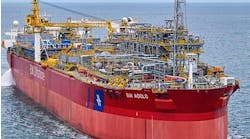Robert Mueller
Fugro GEOS
After a decade in service in the offshore oil and gas industry, large autonomous underwater vehicles (AUVs) have demonstrated their worth and are routinely specified for deepwater surveys. Smaller AUVs have struggled for acceptance, but as the technology improves, costs come down, and experience is gained, the coming decade may see compact AUVs for commercial service.
Although small or compact AUVs are popular for research and military applications, until recently there has been no compelling reason for the offshore survey industry to use them. This is partly because small AUVs have had a limited underwater endurance and payload capability. Furthermore, within the shallow water arena in which they operate, compact AUVs have not been competitive commercially compared with the well-tested and reliable ship-borne survey spreads that they are supposed to replace.
Nevertheless, development of compact AUVs has continued and advanced to the stage where these vehicles may be able to cost effectively perform some survey tasks traditionally conducted from a vessel or ROV.
The Gavia AUV
Some of the technological advances are evidenced in the Gavia AUV manufactured by Hafmynd Ehf. This “low-logistics” vehicle is around 3 m (9.8 ft) long and weighs 90 kg (198 lb). Numerous features have been incorporated into this vehicle to target requirements of the offshore survey industry, namely:
- A Kearfott T-24 Inertial Navigation System (INS) combined with a Doppler Velocity Log (DVL) reduces position drift to as low as 1 m (3.28 ft) per hour of survey
- A 500 kHz GeoSwath Plus echo sounder provides bathymetric and backscatter data
- A downward-looking still camera can record color images of the seabed at a rate of three frames per second
- A Seebyte AutoTracker module that can “lock” the AUV onto a pipeline for high-resolution inspection surveys.
The Gavia also features a standard 900/1,800 kHz side-scan sonar, collision avoidance sonar, acoustic modem, Wi-Fi connectivity, and mission planning software.
Offshore trials
In late 2009, with the support of Woodside Energy, Fugro took delivery of the first Gavia AUV sold to the commercial sector. A series of customer acceptance trials, designed to confirm the operational status of the various onboard systems, were held in Perth, Western Australia.
The program began in shallow water in the Swan River, moving over the course of several days into progressively deeper water. On the final day of the trials the AUV successfully carried out a mission in a water depth of 1,000 m (3,280 ft), the vehicle’s maximum design depth. Several minor issues were identified during the tests and have been rectified, but overall the trials proceeded smoothly and the Gavia AUV proved itself to be a capable and reliable survey platform.
Various parameters relevant to the offshore survey industry were defined or confirmed over the course of the trials and during subsequent test dives. These included:
Endurance. With two battery modules (the maximum possible) and all systems operational, the underwater endurance of the Gavia AUV is 7-8 hours. The most efficient survey speed is 4 knots, at which rate a 1 km by 1 km site (.62 x .62 mi) (total 26 line km [16 mi]) can be surveyed in less than five hours (including line turns).
Position accuracy. The Gavia AUV model discussed in this article does not employ differential GPS corrections. Underwater, the AUV’s position is unaided by acoustic updates and relies solely on its INS and DVL. The degree to which the AUVs position error will grow over time without external input depends on a number of factors, including water depth, water currents, and survey layout.
During trials, the position discrepancy between the same seabed target scanned two hours apart (i.e. at the start and end of a mission) in 100 m (328 ft) of water was measured as 2 m (6.56 ft). During another test in 20 m (65.6 ft) of water, the same target, 500 m (1,640 ft) from the point where the AUV submerged, was scanned by three separate missions. The maximum difference in the measured position of the target from each of these three missions was 3 m (9.84 ft).
Data quality. The side-scan sonar at 900 kHz has an effective maximum range to either side of the AUV of 40 m (131 ft). The range at 1,800 kHz is only 10 m (32.8 ft), but images have a very high resolution and objects as small as a car tire can be clearly resolved.
The GeoSwath Plus echo sounder has an effective range to either side of the AUV about eight times the height of the AUV above the seabed. That is, with the AUV flying 5 m (16 ft) above the seabed, a swath width of 80 m (262 ft) - 40 m (131 ft) to either side of the AUV - will be recorded. Backscatter data, equivalent to that from a 500 kHz side-scan sonar, also is recorded.
Gavia’s downward-looking camera records color images at a resolution of 800 x 600 pixels. With the AUV 4 m (13 ft) above the seabed, each photograph images an area of seabed 4 x 3 m (13 x 9.8 ft) in size. Illumination is provided by an array of LEDs, but due to the rapid absorption of light in water, images recorded below 50 m (164 ft) water depth have a limited color range. Black and white photos can be taken at a higher resolution of 1,600 x 1,200 pixels.
Pipeline inspection. Use of the Gavia AUV is expected to reduce costs and improve data quality for a number of mapping tasks ranging from environmental surveys to debris surveys in confined areas and high-resolution seabed surveys in deepwater.
The primary task for which the AUV was specified, however, is acoustic inspection of pipelines, particularly those in water depths greater than several hundred meters. At those depths a towed sensor is difficult to deploy and position and use of an ROV can be costly. AutoTracker software incorporated into the AUV uses the side-scan sonar data in real time to maintain the AUV at a constant distance from the pipeline.
Ongoing development
In order to improve the position accuracy of the AUV further, it will require the ability to incorporate industry-standard differential GPS corrections such as those supplied by the Starfix and C-Nav networks. Underwater, the ability to aid the AUVs position with acoustic updates would also be desirable. Development of both these options should be available by the end of this year.
The Gavia AUV uses a modular design in which various modules (for example, the GeoSwath module or the extra battery module) can be added or removed as required. The final module needed to complete the Gavia AUV as a fully-featured survey tool is a sub-bottom profiler. In this case, development, using a low-power, parametric transducer, also is well advanced.
Acknowledgements
Fugro acknowledges the long-standing commitment by Woodside Energy to support the introduction of new technology, such as the Gavia AUV, into the offshore survey industry.






